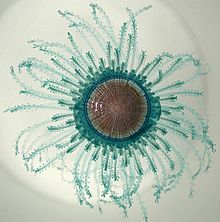Porpitidae
| Chondrophores | |
|---|---|
 |
|
| Blue Button, Porpita porpita | |
| Scientific classification | |
| Kingdom: | Animalia |
| Phylum: | Cnidaria |
| Class: | Hydrozoa |
| Order: | Anthomedusae |
| Suborder: | Capitata |
| Infraorder: | Zancleida |
| Family: | Porpitidae |
| Type genus | |
|
Porpita |
|
| Genera | |
| Synonyms | |
|
Chondrophora Totton, 1954 |
|
Chondrophora Totton, 1954
Velellidae Brandt, 1835
The chondrophores or porpitids are a small and very unusual group of hydrozoans today classified as family Porpitidae. Though it derives from an outdated name for this lineage (see below), some still find the term "chondrophore" useful as a synonym to "porpitid" in discussions of the three genera contained therein.
They all live at the surface of the open ocean, and are colonies of carnivorous, free-floating hydroids whose role in the plankton community is similar to that of pelagic jellyfish. The chondrophores look like a single organism but are actually colonial animals, made up of orderly cooperatives of polyps living under specialized sail-structures.
The most familiar members of the family Porpitidae are the Blue Button (Porpita porpita) and the By-the-wind Sailor (Velella velella).
The tiny individual animals are specialized to perform specific tasks; some form the central gas-filled disc (which is a golden brown colour and hardened by chitinous material) essential to keeping the colony afloat; others form radiating tentacles for tasks such as catching prey, reproduction, and digestion. Microplankton is a chondrophore's principal prey. Although none have powerful stings, contact with the skin may cause irritation. At the mercy of winds and currents, chondrophores are pelagic and drift in the open ocean. They are often seen in large aggregations; mass beachings are not unusual. Chondrophores multiply by releasing tiny (0.3-2.5 millimetres or 0.01-0.09 inches) medusae which go on to develop new colonies.
...
Wikipedia
